
Greenhouse Disease Management
October 2, 2023, 11:49 am
It is important to know what disease you are trying to prevent or control. When diseases are not successfully controlled or become recurring problems, it is often because the cause was not accurately identified.
Greenhouse Disease Management
Considering that many fungicides have a narrow spectrum of activity, an accurate diagnosis is particularly important. Also, non-infectious diseases can mimic those caused by microorganisms.
Fungicides cannot correct a problem caused by high soluble salts, poor aeration or nutrient imbalance. Become familiar with the major diseases that affect each crop, the symptoms associated with each disease, the conditions that favour disease development and how to manage each disease. Three components are required for disease to develop: a susceptible host plant, the pathogen and environmental conditions favourable for disease development.

These three components comprise the three sides of the “disease triangle.” Aim your management practices at reducing one or more sides of the triangle, thus reducing the amount of disease. Important principles of plant disease management include the use of resistant cultivars, sanitation, sound cultural practices and often fungicides. A holistic or integrated approach to plant disease control is the best approach and is highly encouraged.
Resistant Cultivars
A safe and low input way to manage plant diseases is to grow resistant cultivars (varieties) of a crop. If a particular disease is prevalent in your geographic area, determine if appropriate resistant cultivars are available.
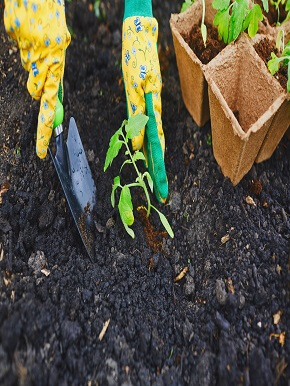
Sanitation
Sanitation greatly enhances management of greenhouse diseases. Remove all diseased plants from the greenhouse. At the end of each cropping cycle, discard unsold stock. Plants carried over from previous crops may harbour plant pathogens. Inspect each lot of plants and, if disease is present, discard or treat them immediately. Maintain a disease prevention program for stock plants.

Inspect stock plants for disease and do not take cuttings from infected plants. If a knife is used to take cuttings, dip it in a disinfectant, such as a 10% household bleach solution, or commercial product for this purpose before moving from one stock plant to the next. Transport the cuttings in clean containers and work on a sanitized surface. Clean newspaper provides a relatively sanitary surface.
Before growing a crop, clear the greenhouse of plant debris, weeds, flats and tools. Wash and disinfect empty benches, potting tables, storage shelves, tools and pots to remove media and plant debris. Ventilate the area if using sodium hypochlorite (household bleach) for this purpose, as bleach can be toxic to some plants, especially poinsettia.
After the greenhouse has been sanitized, avoid recontamination with pathogens. Purchase seeds, bulbs and cuttings from reliable sources. Use culture-indexed cuttings, if available, to reduce the chance of introducing pathogens. Seeds and bulbs should be disinfected by chemical and/or heat treatment, preferably by the seed company.
Growing media are easily reinfested by way of dirty hose nozzles and tools. Provide a hook to keep hose nozzles off the floor. Hang up tools after cleaning them with soap and water. Sodium hypochlorite (household bleach) diluted at the rate of 1 part bleach (5.25%) to 9 parts water is a good general disinfectant for tools, pots and bench tops. Rinse with water after treatment to prevent corrosion of metallic surfaces. Commercial disinfectant products are available that are made for this purpose.
When working with plants such as cleaning or propagating, work in blocks and clean hands and tools between blocks. If gloves are worn, clean or change them between blocks. The same is true when working with incoming plants, always work in blocks and if possible keep plants from different suppliers separated.
Cultural Practices
Soil-borne pathogens are spread by splashing of spores and/or contaminated soil. Drip irrigation and ebb-and-flow systems help minimize splashing and pot-to-pot splashing of soil associated with hand watering. They also eliminate the use of a hose nozzle, which may periodically touch the growing medium along the bench. However, ebb-and-flow systems can become contaminated with pathogens and result in rapid and widespread infection of the crop.
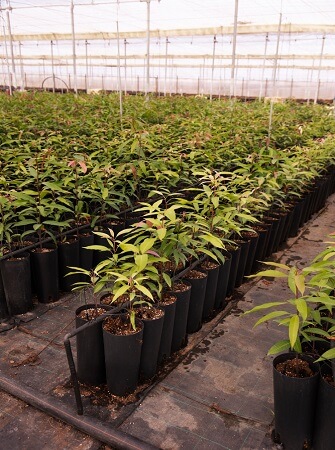
Root rots caused by the fungi Pythium and Phytophthora are enhanced by high soil moisture and high soluble salts. Rhizoctonia is favored by a drier medium. Select a well-drained medium, test for soluble salts periodically, and apply water for optimum growth of the crop.
Use separate greenhouses for vegetable plants and ornamental plants to protect vegetable plants from tospoviruses; protect cucurbit seedlings from powdery mildew and to make it easier to treat vegetable plants if pesticides are needed.
High relative humidity is one of the major factors contributing to mildew and disease problems in the greenhouse, especially botrytis blight. High humidity is especially troublesome when greenhouses are tightly sealed to conserve energy. Cool nights also increase humidity. Warm air holds more moisture than cold air. During warm days the greenhouse air picks up moisture. As the air cools in the evening, especially during spring and fall, the moisture-holding capacity drops until the dew point is reached and water begins to condense on surfaces.
Relative humidity can be lowered by three methods:
1. Keep the vents open an inch or so (or run exhaust fans at low capacity) when the heat comes on in the late afternoon. This allows cooler air to enter the greenhouse while warm moist air leaves. As the entering cooler air is heated, relative humidity drops. After 5 to 10 minutes, close vents or turn off fans.
2. When extremely moist conditions exist in a greenhouse, it may be necessary to exchange the air several times at night. Equipment can be purchased to turn on exhaust fans at predetermined times. The fans should remain on long enough to exhaust one volume of air.
Heat loss is small, since the mass of the exhausted air is small relative to the combined mass of the greenhouse structure, plants, media, floor, etc., which hold heat inside the greenhouse. Humidity can further be reduced by watering early in the day when the warm air can absorb moisture from wet surfaces.
3. Moving air in the closed greenhouse helps reduce water on plant surfaces. A horizontal air flow system or the overhead polyethylene ventilation tube system minimizes temperature differentials and cold spots where condensation is likely to occur.
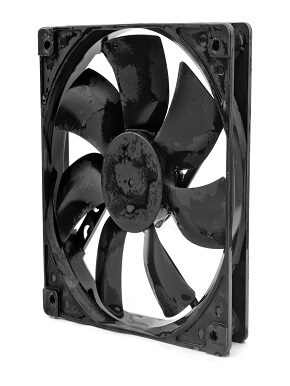
Overgrown plants are more prone to diseases such as Botrytis and make it difficult to obtain adequate fungicide coverage. Proper planting dates, plant nutrition, watering practices and height management techniques help to prevent lush, overgrown plants. Proper spacing will also lower humidity within the plant canopy.
Causes of Plant Diseases
Bacteria
Bacteria are very small microorganisms. Under the high power (1,000 X) of a compound microscope they appear as tiny rods. To put their size into perspective, approximately 600 bacteria lined up end-to-end would measure 1/16. Bacteria can multiply very rapidly, doubling their populations every 30–60 minutes.
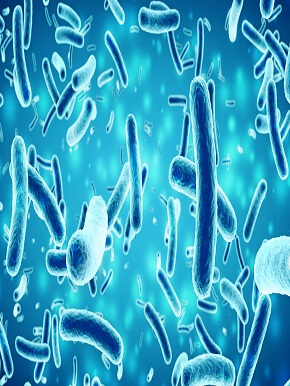
With few exceptions, plant pathogenic bacteria cause disease by colonizing the internal tissues of plants, thereby interrupting normal growth and function. Bacteria cause a variety of symptoms including leaf spot, bud rot, canker, vascular wilt, soft rot and galls. Symptoms caused by bacteria are often indistinguishable from those caused by fungi. Soft rot bacteria like Erwinia chrysanthemi invade the space between cells and dissolve the cementing material (pectin), resulting in the characteristic symptoms of soft rot.
On the same host, Pseudomonas cichorii, which is unable to produce pectic enzymes, causes a dry lesion as opposed to a soft rot. Bacteria that colonize the vascular system cause systemic disease. When bacteria become systemic, they are transported relatively rapidly throughout the vascular system. The plant wilts due to the plugging of the water-conducting cells. Some systemic bacteria, such as Xanthomonas campestris pv. pelargonii, also produce pectic enzymes that cause rot in later stages of disease.
Management Practices for Bacterial Diseases
Copper products are very toxic to bacteria as well as many fungi. However, pesticides are only marginally effective unless coupled with sound cultural practices. Since bacteria are spread by water splash, insects, handling and pesticide applications, diseased plants should be promptly isolated from healthy plants or discarded. Space plants adequately to allow for quick drying after watering. Discontinue overhead watering when bacterial diseases are evident. Reduce relative humidity and avoid prolonged periods of leaf wetness. When propagating geraniums, snap cuttings from the plant or, if a knife is used, disinfest it at least when moving from one stock plant to the next. Wholesale propagators of geraniums should culture-index stock plants.

Viruses
Viruses are ultra-microscopic, infectious particles composed of nucleic acid surrounded by a protein coat. Virus particles multiply only within living host plant cells where they disrupt normal cell functions. Viruses can spread systemically throughout the host plant, and plants may be infected even when symptoms of disease are not apparent. Many different viruses can infect floricultural crops. Some, like cymbidium mosaic virus, have a narrow host range. Others, like cucumber mosaic virus and impatiens necrotic spot virus, can infect a wide variety of greenhouse plants as well as vegetable crops and weeds.
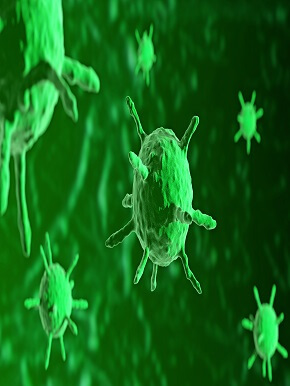
Symptoms of virus infection are most evident on foliage. Mosaic, which is a variable pattern of chlorotic and healthy tissue on the same leaf, is a common symptom. Other foliar symptoms include leaf crinkle or distortion, chlorotic streaking (especially in monocots), ringspots, line patterns and distinct yellowing of veins. Flowers of virus-infected plants may be deformed, or show streaks or flecks of abnormal petal color. A more subtle but very common symptom of virus disease is stunting of the plant. Symptoms may be masked under certain environmental conditions or at particular times of the year, making their diagnosis more difficult.

The spread of viruses in greenhouses occurs in a variety of ways, depending on the virus. Mechanical transmission through handling of plants or use of infested tools is an efficient means of spreading tobacco mosaic virus. However, most viruses are not easily spread in this manner. Some, such as tomato ringspot virus, can be transmitted through infected seed. The most efficient way to spread viruses in floriculture crops is by vegetative propagation of infected stock plants. In this manner, viruses are passed on through successive crops. Insects such as aphids, thrips, mites, and leafhoppers are the most important vectors of viruses.
Management Practices for Virus Diseases
It is of primary importance to have the virus disease accurately identified. Casual on-site diagnosis is often inaccurate due to confusion of symptoms with other viruses, nutritional disorders, chemical injury, insect feeding and other problems. Serological techniques are currently available to accurately identify a wide range of viruses. Once identified, more specific control strategies can be developed. There are no chemical control measures for virus diseases other than those directed at the vectors.
Management practices include starting crops with virus-free seed or cuttings, eradicating weed hosts, reducing insect vectors and destroying diseased plants. Some propagation specialists provide virus-indexed plant material. In the virus-indexing process, stock plants are evaluated for the presence of specific viruses through the use of indicator plants or serology and molecular techniques. Virus-indexed plants are not immune or resistant to subsequent virus infection.
Proper sanitation practices are necessary to prevent virus infection. Weed control and removal of crop debris can eliminate possible reservoirs of virus infected material. Insect control may help to inhibit the spread of certain viruses. Reduction or elimination of thrips is essential for controlling the spread of the tospoviruses INSV and TSWV. Reduced handling of plants can minimize the mechanical transmission of tobacco mosaic virus. Destroy virus-infected plants.
Management Practices for Tospovirus
Tospovirus is a virus family that includes impatiens necrotic spot virus (INSV) and tomato spotted wilt virus (TSWV). Tospoviruses, particularly INSV, are the most important viruses in the floriculture industry. These viruses are spread by the Western flower thrips. The virus is not seedborne but is brought into the greenhouse on plants that have been exposed to the virus.

Once the thrips in the greenhouse pick up the virus they can transmit it to weeds and crops. To manage tospoviruses, it is necessary to get rid of all infected plant material, eliminate thrips and eradicate all weeds. Do not grow vegetable transplants in the same greenhouse as ornamental bedding plants. Inspect plants carefully for symptoms of virus and thrips before bringing new plants into the greenhouse.
Nematodes
With a few exceptions, nematodes are not an important problem in the greenhouse industry in Nigeria. There are several reasons for this. Soilless media are devoid of plant parasitic nematodes and subsequent contamination is not likely. Also, the relatively short length of time most crops are grown limits the ability of nematodes to build up to damaging levels.
Nematodes are small (0.03 to 0.75 inches long) roundworms that are common inhabitants of field soil. Most nematodes are not parasitic to plants but prey on microorganisms, insects and other nematodes. Plant parasitic nematodes are specialized to parasitize plants. Depending on the genus of nematode and the host involved, roots, stems or leaves may be colonized. With regard to root-colonizing species, root-knot nematodes (Meloidogyne spp.) are among the important in outdoor crops such as herbaceous perennials.

As the common name implies, symptoms appear as galls of various sizes (up to ¼ inches diameter) on the roots. Root-knot nematodes have a fairly wide host range that includes many greenhouse plants. The bulb and stem nematodes (Ditylenchus spp.) occur in hyacinth, narcissus, tulip, mountain and annual phlox and iris, as well as other plants.
Colonized bulbs may display necrotic areas, and leaves may produce swellings and distorted growth. Foliar nematodes (Aphelenchoides spp.) occur on Anemone, Indian rubber plant, birds nest fern, African violet, gloxinia, Rieger begonia, chrysanthemum, Monarda, Phlox subulata, Boston fern, Easter lily, Lamium and Peperomia. Symptoms may be mistaken for those of fungal or bacterial infections. Root-knot nematodes occur primarily as contaminants of field soil but they may also be brought in on plant material. The bulb and stem nematode may occur in field soil or as a bulb inhabitant. Foliar nematodes are brought into the greenhouse on plant material.
Management Practices for Nematodes
Nematode problems can be avoided by using a soilless medium, purchasing plant material from a reputable source, and inspecting plants known to be commonly infected. When the bulb and stem nematode or foliar nematode appears, destroy infected plants and do not reuse media. When root-knot nematodes occur in beds, steam or fumigate the soil prior to the next crop.
Fungi
The majority of plant diseases are caused by fungi. Fungi are not plants and are distinct from plants in their inability to photosynthesize. Fungi are filamentous, highly branched microorganisms that grow over or through the substrate that provides them with nutrients. Those fungi that have evolved into plant pathogens attack living plants, and in horticultural crops, cause loss of yield or aesthetic value. Fungi are extremely diverse in their ecology, growth habits, form and pathogenicity.
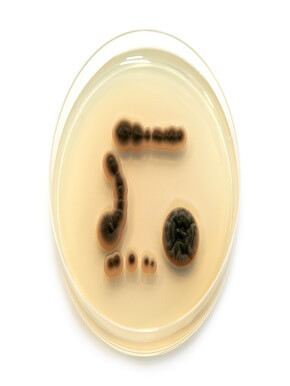
Symptoms of fungal diseases are also highly variable. Fungi that survive and reproduce in the soil are termed soil-borne. They are the principal cause of damping-off, and rootand crown rot. Soil-borne fungi generally do not produce air-borne spores but areeasily transported from contaminated soil to pathogen-free soil by tools, hose ends, transplants, water-splash and hands. Fungi that cause disease of stems, foliage and flowers usually produce spores that are easily disseminated by air currents, splashing water or insects.
Fungicides: Fungicides play an important role in Integrated Pest Management (IPM). Sometimes they are the most effective component, but in other cases, their use may be ineffective, inappropriate, or illegal. To maximize the usefulness of fungicide treatments, use them in an informed and intelligent manner. An accurate diagnosis of disease (the cause of the symptoms) is necessary for the development of an effective IPM program. It is important to identify the pathogen, its host range, know the optimum conditions for its development, and its sensitivity to specific fungicides.
A pesticide’s effectiveness is not related to the number of crops on its label. Factors to consider are formulation (wettable powder, flowable, etc.), residue, spectrum of activity, resistance management, and safety. Pesticide users are responsible for making sure products are registered for use on specific crops and for using products according to label directions.
Resistance Management
It is important to use fungicides intelligently to prevent them from losing effectiveness. Resistance may result in poor or no disease control. Fungicides are classified as systemic (penetrant) or protectant (contact). Systemic chemicals are absorbed into plant tissues. Protectant materials act as a barrier to fungal infection, and do not penetrate plant tissue. In addition, fungicides are grouped by their mode of action (MoA), and each MoA group is assigned a Fungicide Resistance Action Committee Group number (FRAC code). Most systemic fungicides are specific in their mode of action; thus, it requires very little genetic change in fungus populations for resistance to develop. Protectant fungicides are less likely to develop resistance problems, as they have multi-site modes of action (FRAC codes preceded by “M”). Cross resistance can also occur among members within a chemical group.
If you would like to start greenhouse farming in Nigeria and you need a greenhouse farming business plan or consultation service, please send a mail to agsolutions@agricdemy.com
With our greenhouse farming business plan, you will learn:
- The different greenhouse sizes available and the materials required to build them
- The different fruits and vegetables you can grow in the greenhouse and their yields
- The cost of building and constructing a greenhouse based on the size you want
- Profit and loss estimates for the first three years of running one unit of greenhouse
- Vegetable and fruit market analysis in Nigeria
- Marketing and sales strategy for running a successful greenhouse in Nigeria
- Personnel required to operate your greenhouse, key milestones and so much more!
For a payment of $35 or N50,000 you can get our greenhouse farming business plan. To get payment details, send a mail to agsolutions@agricdemy.com
If you want to learn more about greenhouse farming, check out more articles in our Greenhouse Farming section and watch our Greenhouse Farming video tutorials.
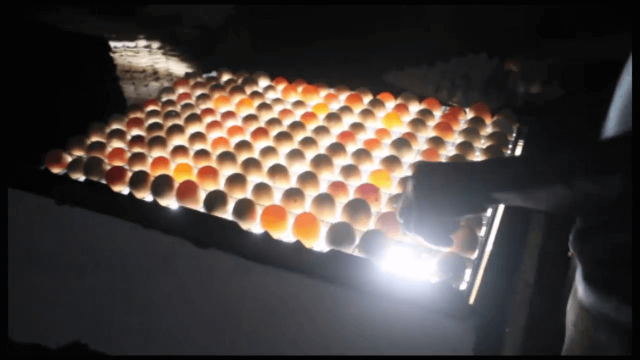



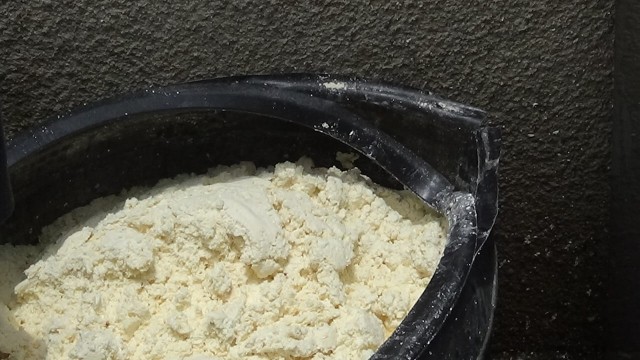


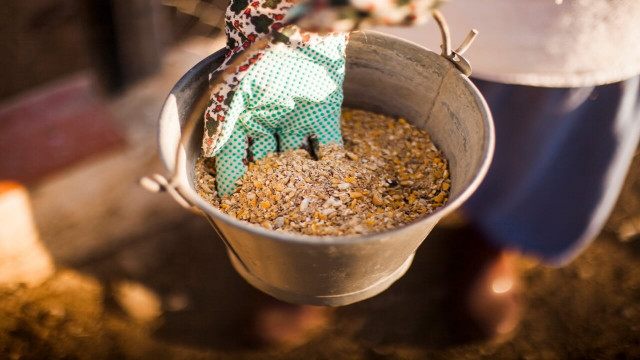


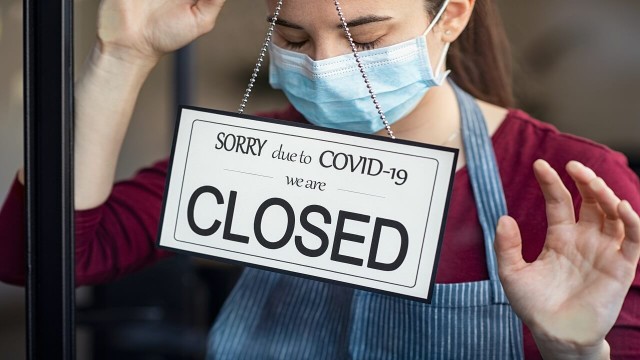
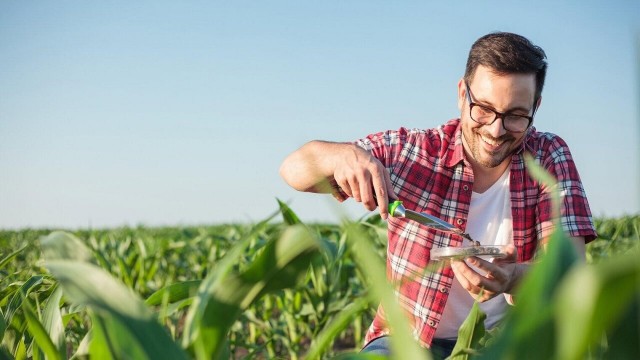
Share This Article: